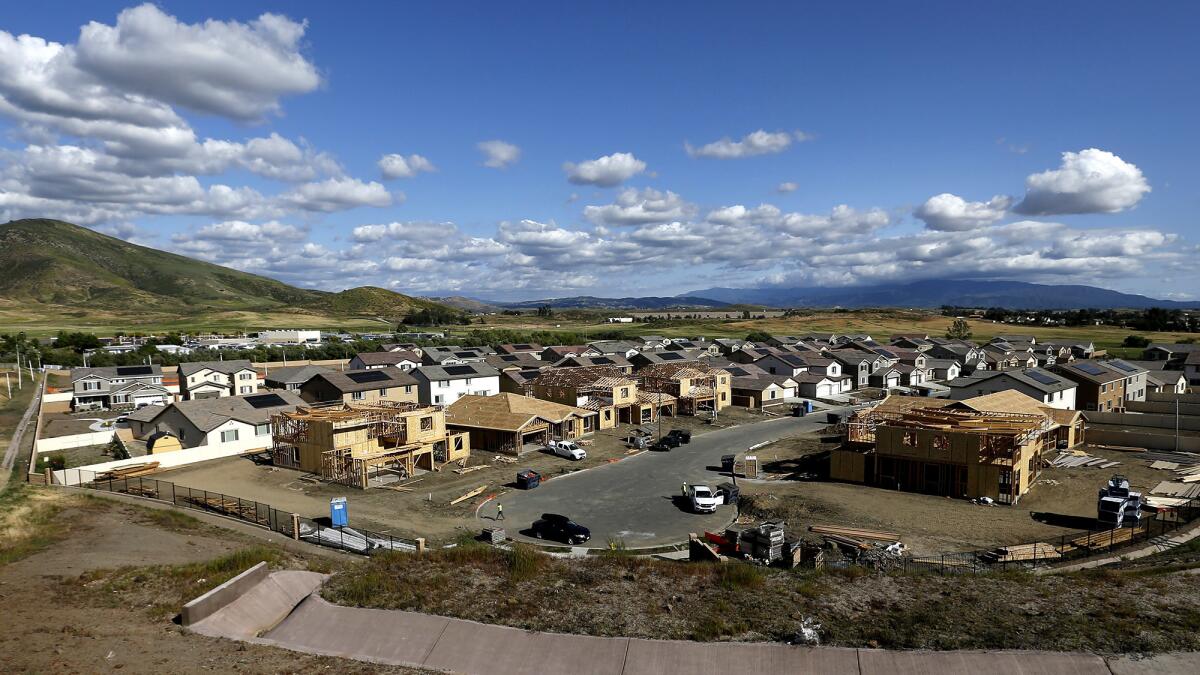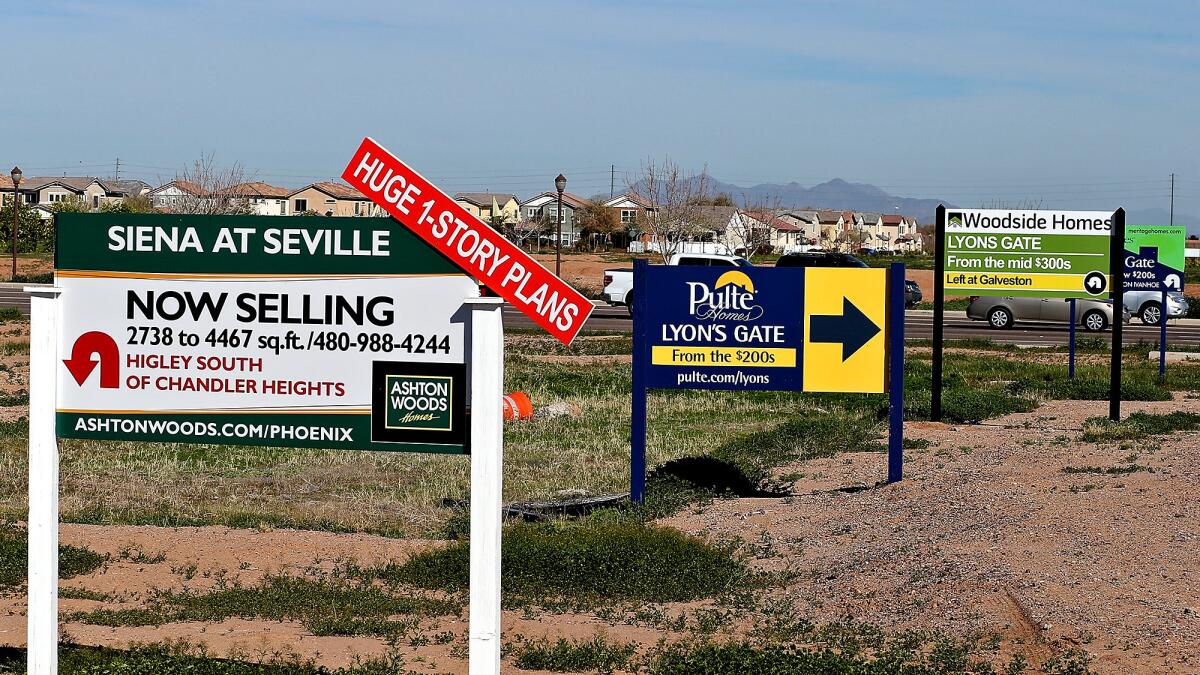Leaving coastal California is a ‘no-brainer’ for some as housing costs rise
- Share via
Huntington Beach residents Chris Birtwistle and Allison Naitmazi were about to get married and decided it was time to buy a home.
They wanted to stay in the area but couldn’t find a house they both liked and could reasonably afford — despite a dual income of around $150,000.
So they decided to go inland — all the way to Arizona, where they recently opened escrow on a $240,000, four-bedroom house with a pool just outside Phoenix. Their monthly mortgage payment will be about $500 less than what they paid for a two-bedroom apartment in the Orange County beach community.
“The only hesitation was [leaving] the great weather,” the 31-year old Birtwistle said. “But we talked about what we can get here and what we can get there for the same price and that was a no-brainer.”
Residents of coastal Southern California are increasingly making the same decision to move away — a trend many economists blame on a housing shortage driving rents and home prices sharply higher during the economic recovery.

Moves out of the area remain far below levels seen during last decade’s housing bubble, when out-migration was nearly triple what it was in 2016 — and real estate agents urged clients to “drive until you qualify.”
But after slowing down in the aftermath of the Great Recession, which devastated the housing market, out-migration is picking up as prices climb steadily higher, according to U.S. Census Bureau data.
To escape high prices, people — often younger and with lower- or middle-class incomes — are looking toward the Inland Empire and nearby states for additional square footage and a lower mortgage payment.
“[Migration] is settling back into longer-term patterns,” said Jed Kolko, chief economist with employment website Indeed.com who analyzed the data.
Others were more blunt.
“The impact is to create an auction situation between the haves and the have-nots,” Christopher Thornberg, founding partner of Beacon Economics, said of the housing shortage. “And the have-nots have to move away.”
In 2016, about 75,000 more people left Los Angeles County than moved here from other places in the United States, the data show. That rate of “negative domestic migration” is 21% more than a year earlier, and nearly double the level seen in 2012 when moves away from the county had bottomed out.
A similar trend exists in Orange County, where the median price of $645,000 is higher than the peak last decade, a level not yet hit in L.A. County.
Detailed data on who moved and where is not available yet for 2016, but it is for previous years.
In 2015, the top destination for those leaving L.A. County was the Inland Empire, followed by Nevada, Arizona and Kern County. In Orange County, most left for the Inland Empire, Idaho, San Diego County and Arizona.
Younger people and those with low and moderate incomes moved out at the greatest rate, though negative domestic migration was seen among people of all generations and income brackets, including households with incomes of $100,000 to $200,000.
“People still want to be here,” said Jordan Levine, an economist with the California Assn. of Realtors, who compiled the age and income data. “It’s just a question if you can afford to be here. Higher-income people and those with more education have a better shot, but even they are struggling.”
That includes people such as former Huntington Beach residents Birtwistle and Naitmazi, who are purchasing a nearly 2,260-square-foot home in Avondale, Ariz. The mortgage comes with monthly payment of only $1,300.
Similar-sized homes in Huntington Beach are going for a minimum of $800,000, and Birtwistle said their options in Orange County were limited because they wanted to stay in a neighborhood with good schools and low crime rates.
In Arizona, Birtwistle said his fiancee was able to keep her marketing job, while he secured a new one as a manager for a used car retailer.
“Really, the desire to move outside of California was to do with wanting to have more financial stability,” he said.
The population in Los Angeles and Orange counties is still growing, a result of births and immigration from other countries. Jobs are on the rise too.
But as people such as Birtwistle leave, some businesses and economists are becoming concerned.
“How do we grow our economy when we can’t recruit the workers who can come here and have a decent quality of life?” Levine said.

Rob Lapsley, president of the California Business Roundtable, a senior executives group, said housing has “quickly risen to the top of issues impacting decisions in the boardroom.”
Businesses are struggling to recruit and some are putting off expansions, Lapsley said, while others are moving mid-level office jobs to neighboring states.
“They are moving folks in order to provide a better quality of life,” he said, noting employees will also take a lower salary in a less-expensive state. “It’s a win-win.”
A recent report from USC and the Los Angeles Business Council cited local departures, including Toyota’s move of its North American headquarters to Texas, as job losses probably driven in good part by high housing costs.
At Ytel, a software company in the Lake Forest neighborhood of Foothill Ranch, some employees commute an hour each way to work, unable to afford a house in a city with a median price of $727,000.
“It’s highly inefficient,” founder and Chief Executive Nick Newsom said. “After a long commute it can take time to realign your focus to the workday.”
To help, Newsom said he lets employees work from home and use video conferencing. Or they can work flexible hours so they can drive in after rush hour.
“In my dream world, I would want my employees to have homes close to the office,” he said. But “it’s difficult for them to do and you’ve got to make a very good [salary] to live in south Orange County.”
It’s a problem that extends beyond Southern California.
From 2007 to 2014, 502,000 more residents earning below $50,000 annually moved out of the state than moved in, while people earning above that level moved in at a greater rate than they left, according to a recent report from Beacon Economics.
If affordability doesn’t improve, lower- and middle-income households will increasingly leave, Beacon principal Thornberg said. But he predicted that wealthy individuals will still come and the economy would just grow slower and tilt toward the rich.
“People moving out of the area, is that a problem? Not necessarily,” Thornberg said. “A lot of it has to do with what your goals are.”
For former Irvine residents Christie Serrao and her husband, their goal was to give their two young children their own rooms and a large backyard.
The stay-at-home mom and account executive — who described themselves as comfortably middle-class — said they were priced out in Orange County.
So last fall, they purchased a five bedroom, $434,000 home in a new subdivision near Temecula built by Irvine-based CalAtlantic Homes.
Serrao, 41, said her husband’s commute has stretched from five minutes to nearly two hours. But Serrao said the move has been worth it.
Her husband works remotely three days a week and her children, ages 4 and 6, have a lifestyle that would’ve been difficult to afford in Orange County.
“The kids can ride bikes in the backyard and I can cook dinner and not have to worry about them,” she said.
Did you leave coastal California? Tell us why in the comments below, or on the Times’ Facebook page.
Follow me @khouriandrew on Twitter
ALSO
California housing bills could take away subsidies for homeowners and add them for renters
Delay for Boyle Heights homeless project shows challenge of building thousands of units in L.A.
One solution to Southern California’s housing crisis: building in tight spaces, small lots
More to Read
Inside the business of entertainment
The Wide Shot brings you news, analysis and insights on everything from streaming wars to production — and what it all means for the future.
You may occasionally receive promotional content from the Los Angeles Times.











